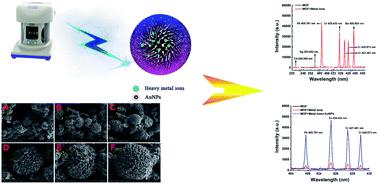当前位置:
X-MOL 学术
›
J. Anal. At. Spectrom.
›
论文详情
Our official English website, www.x-mol.net, welcomes your feedback! (Note: you will need to create a separate account there.)
Nanoparticle-assisted metal–organic framework (MOF) enhanced laser-induced breakdown spectroscopy for the detection of heavy metal ions in liquid samples
Journal of Analytical Atomic Spectrometry ( IF 3.4 ) Pub Date : 2021-08-23 , DOI: 10.1039/d1ja00182e Xiaojiao Liu 1, 2 , Jiao Liu 2 , Qingyu Lin 3 , Wenlong Liao 4 , Tao Yang 1, 2 , Cheng Qian 1, 5 , Yixiang Duan 1, 2
Journal of Analytical Atomic Spectrometry ( IF 3.4 ) Pub Date : 2021-08-23 , DOI: 10.1039/d1ja00182e Xiaojiao Liu 1, 2 , Jiao Liu 2 , Qingyu Lin 3 , Wenlong Liao 4 , Tao Yang 1, 2 , Cheng Qian 1, 5 , Yixiang Duan 1, 2
Affiliation

|
In recent years, the low sensitivity caused by plasma quenching has restricted the development of LIBS technology in practical applications. In order to improve the sensitivity of the LIBS analysis method, we proposed a nanoparticle-assisted metal–organic framework (MOF) enhanced laser-induced breakdown spectroscopy, which combines a metal–organic framework (MOF), Au nanoparticles (AuNPs), and a portable LIBS instrument. Common metal ions in water were selected as the research objects to be tested by the proposed method. First, the synthesized three-dimensional (3D) MOF, namely [Zn2(L2)]2DMA·3H2O (complex 1) [H2L = 2-(imidazole-1-yl)terephthalic acid], was used to capture metal ions. Second, complex 1 loaded with metal ions induced AuNPs to aggregate on its surface. Third, the samples were attached to the glass substrate with double-sided tape and analyzed by LIBS. As a result, the limits of detection (LODs) for Pb and Cr obtained in this work were 8.0 and 4.2 ng mL−1, respectively, which were notably 8–10 times lower than those of the complex 1 enrichment method alone and 4 orders of magnitude lower than those of traditional LIBS methods. The significant improvement in LODs was also a new breakthrough for LIBS in liquid analysis. The great improvement in sensitivity can be mainly attributed to the unique microporous structure and the exposed metal binding sites of complex 1, which provide a huge space to accommodate metal ions. Also, the coupling action between laser electromagnetic fields and the surface plasmon of AuNPs greatly improved the laser ablation efficiency in the process of laser–matter interaction. Finally, the analysis of actual samples yielded good recoveries (92.8–99.0%) and reproducibility (lower than 11.9%), which shows the great potential of the combination of this method and portable LIBS in-field detection.
中文翻译:

纳米粒子辅助金属有机骨架 (MOF) 增强激光诱导击穿光谱用于检测液体样品中的重金属离子
近年来,等离子体淬火引起的低灵敏度限制了LIBS技术在实际应用中的发展。为了提高 LIBS 分析方法的灵敏度,我们提出了一种纳米粒子辅助金属有机骨架 (MOF) 增强激光诱导击穿光谱,它结合了金属有机骨架 (MOF)、金纳米粒子 (AuNPs) 和便携式LIBS仪器。选择水中常见的金属离子作为研究对象,采用该方法进行检测。首先,使用合成的三维(3D)MOF,即[Zn 2 (L 2 )]2DMA·3H 2 O(配合物1)[H 2 L = 2-(咪唑-1-基)对苯二甲酸]捕获金属离子。第二,负载有金属离子的配合物 1诱导 AuNPs 在其表面聚集。第三,用双面胶带将样品贴在玻璃基板上,并通过 LIBS 进行分析。因此,在这项工作中获得的 Pb 和 Cr 的检测限 (LOD) 分别为 8.0 和 4.2 ng mL -1,这比单独的复杂 1富集方法低 8-10 倍和 4 个数量级量级低于传统 LIBS 方法。LOD 的显着提升也是 LIBS 在液体分析方面的新突破。灵敏度的大幅提高主要归因于复合物 1独特的微孔结构和暴露的金属结合位点,提供了容纳金属离子的巨大空间。此外,激光电磁场与AuNPs表面等离子体之间的耦合作用大大提高了激光-物质相互作用过程中的激光烧蚀效率。最后,实际样品的分析产生了良好的回收率(92.8-99.0%)和重现性(低于 11.9%),这表明该方法与便携式 LIBS 现场检测相结合的巨大潜力。
更新日期:2021-09-06
中文翻译:

纳米粒子辅助金属有机骨架 (MOF) 增强激光诱导击穿光谱用于检测液体样品中的重金属离子
近年来,等离子体淬火引起的低灵敏度限制了LIBS技术在实际应用中的发展。为了提高 LIBS 分析方法的灵敏度,我们提出了一种纳米粒子辅助金属有机骨架 (MOF) 增强激光诱导击穿光谱,它结合了金属有机骨架 (MOF)、金纳米粒子 (AuNPs) 和便携式LIBS仪器。选择水中常见的金属离子作为研究对象,采用该方法进行检测。首先,使用合成的三维(3D)MOF,即[Zn 2 (L 2 )]2DMA·3H 2 O(配合物1)[H 2 L = 2-(咪唑-1-基)对苯二甲酸]捕获金属离子。第二,负载有金属离子的配合物 1诱导 AuNPs 在其表面聚集。第三,用双面胶带将样品贴在玻璃基板上,并通过 LIBS 进行分析。因此,在这项工作中获得的 Pb 和 Cr 的检测限 (LOD) 分别为 8.0 和 4.2 ng mL -1,这比单独的复杂 1富集方法低 8-10 倍和 4 个数量级量级低于传统 LIBS 方法。LOD 的显着提升也是 LIBS 在液体分析方面的新突破。灵敏度的大幅提高主要归因于复合物 1独特的微孔结构和暴露的金属结合位点,提供了容纳金属离子的巨大空间。此外,激光电磁场与AuNPs表面等离子体之间的耦合作用大大提高了激光-物质相互作用过程中的激光烧蚀效率。最后,实际样品的分析产生了良好的回收率(92.8-99.0%)和重现性(低于 11.9%),这表明该方法与便携式 LIBS 现场检测相结合的巨大潜力。


























 京公网安备 11010802027423号
京公网安备 11010802027423号